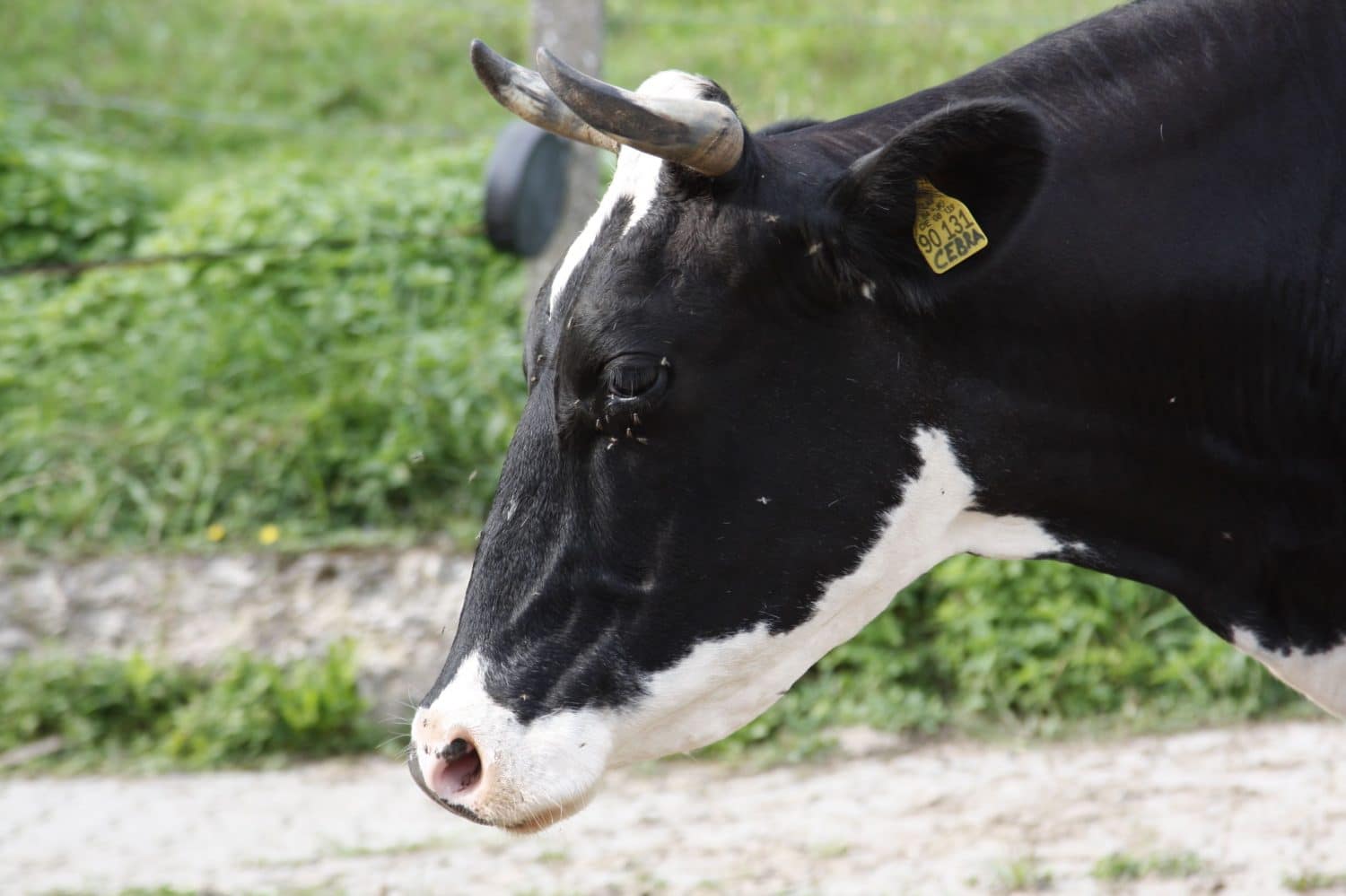… and more drastically the higher you heat it. What are the consequences?
Take home message
- By measuring concentrations of several ingredients in milk, you can see what changes when you pasteurise milk (72oC), or even up to 100oC. Heating caramelises milk, which is caused by clumping of milk sugar (Maillard reaction) with other ingredients.
- Heat-sensitive ingredients are whey proteins (Lactoferrin) and immunoglobulins.
- After heating, undesired bacteria can multiply more easily and cause problems, if recontamination takes place.
- Changed substances on its own do not tell us always, if heating is a problem. Studies in animals and humans show effects of heating on immunology. Raw milk protects against allergy.
For food safety reasons, raw milk is heated before cosumption: pasteurised or sterilised. Although we have long been led to believe, that heating ‘hardly changes anything’ to the nutritional value and especially the efficacy of raw milk, a recent study shows, what type of changes take place for several ingredients (Shuang et al., 2024). This type of research is not new, back in 1980, a Swiss renowned research institute Agroscope, already extensively investigated the changes caused by heating (Blanc, 1980). What is unfortunate about Blanc’s research is that it is hardly impossible to find the article in any library. During the same period, the Swiss not only looked at contents, but also assessed what heating milk means for growth and development in 9 generations of rats (Sieber et al., 1980). The Chinese study revealed, that milk contents react differently to increased steps of heating. Besides raw milk, pasteurised milk treated according to the HTST process was assessed, because the HTST milk is the most consumed pasteurised milk worldwide. HTST means High-Temperature-Short-Time: heated at 72oC for 15 seconds. Further heating steps were added as a comparison: 75, 80, 85, 90, 95 and 100oC for 15 seconds.
Groups of substances
Measured were the impact on immunity (IgG), whey proteins (Lactoferrin, total whey protein concentration), vitamins (C and B2), killing of bacteria (total germ count, coliforms, Staphylococcos aureus and spore formers), but also on the loss of bacteriocidal properties (outgrowth of Escherichia coli and Staphylococcus aureus added after heating), antioxidants (DPPH radical) and caramelisation of the milk sugar and its aggregate formation with other ingredients (the Maillard reaction, measured as furosin).
Heating kills bacteria
The main purpose of pasteurisation is to kill bacteria. This is reflected in the mesophilic (total) germ count. You can additionally measure certain bacterial groups separately, such as coliforms (measure of cleanliness), Staphylococcus aureus (measure of udder infection) and spore formers (measure of hidden contamination), (Figure 1). Coliforms and S.aureus did not grow anymore after the HTST pasteurisation (reduction to 0%). The total germ count is impacted by HTST pasteurisation (over 40% reduction), however, even after sterilisation you do not kill all bacteria (maximum 70% reduction). This is because of the spore-forming bacteria, which can outgrow from the spores, even after milk is sterilised. To get rid of spore-forming bacteria, you have to heat it to 140oC (UHT milk). Only then milk can be left outside the fridge for months without further change; this milk is bacteriologically dead.
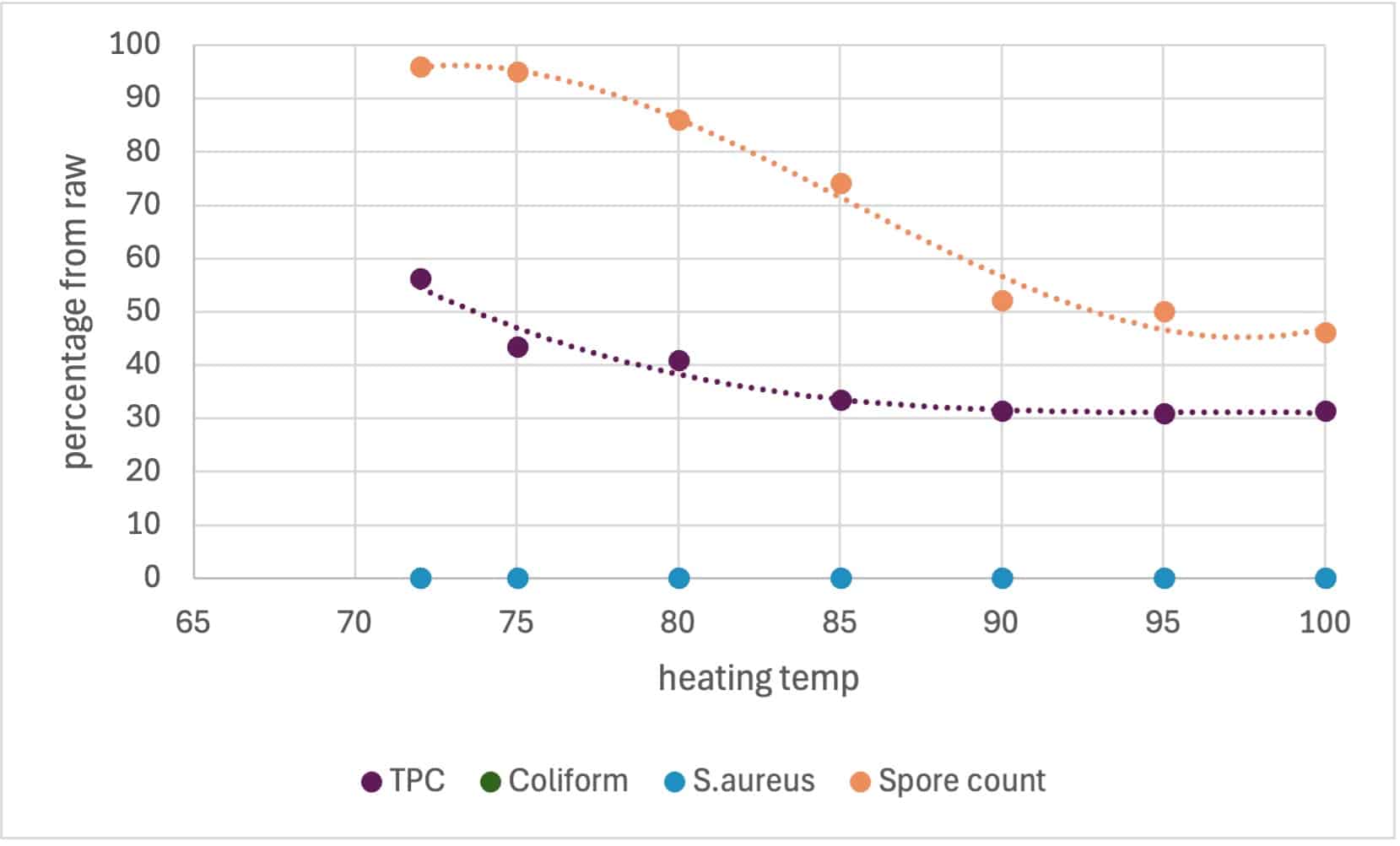
Fig. 1. Decrease due to increasing heating for 15 seconds: total mesophilic plate count (TPC), Coliforms, Staphylococcus aureus and spore formers relative to the value in the raw milk (=100). The log10 quantities of the starting raw milk are 4.7; 2.6; 2.3 and 2.0, respectively. (The line for Coliforms and S.aureus are the same).
Re-contamination after heating: bacteria grow easily
Raw milk has an internal defence system against bacterial growth. Bacteria are inhibited, especially in the first few hours. Milk therefore does not acidify milk immediately and certain zoonoses do not grow out immediately. However, you cannot assume, that therefore every raw milk is safe. The safety of raw milk depends on the initial bacterial contamination, a low E.coli concentration and the immediate cooling of the milk.
What is clear, however, is that after heating milk, protection is lost. The higher the heating temperature, the quicker the added E.coli and S.aureus will multiply.
This is also the problem of re-contamination, i.e. after pasteurisation of milk in a plant, contamination takes place. Such contamination is at least as dangerous as the presence of the bacteria in the raw milk itself. Due to the greater badge of pasteurised milk from the same date, problems are often much greater, though rarer.
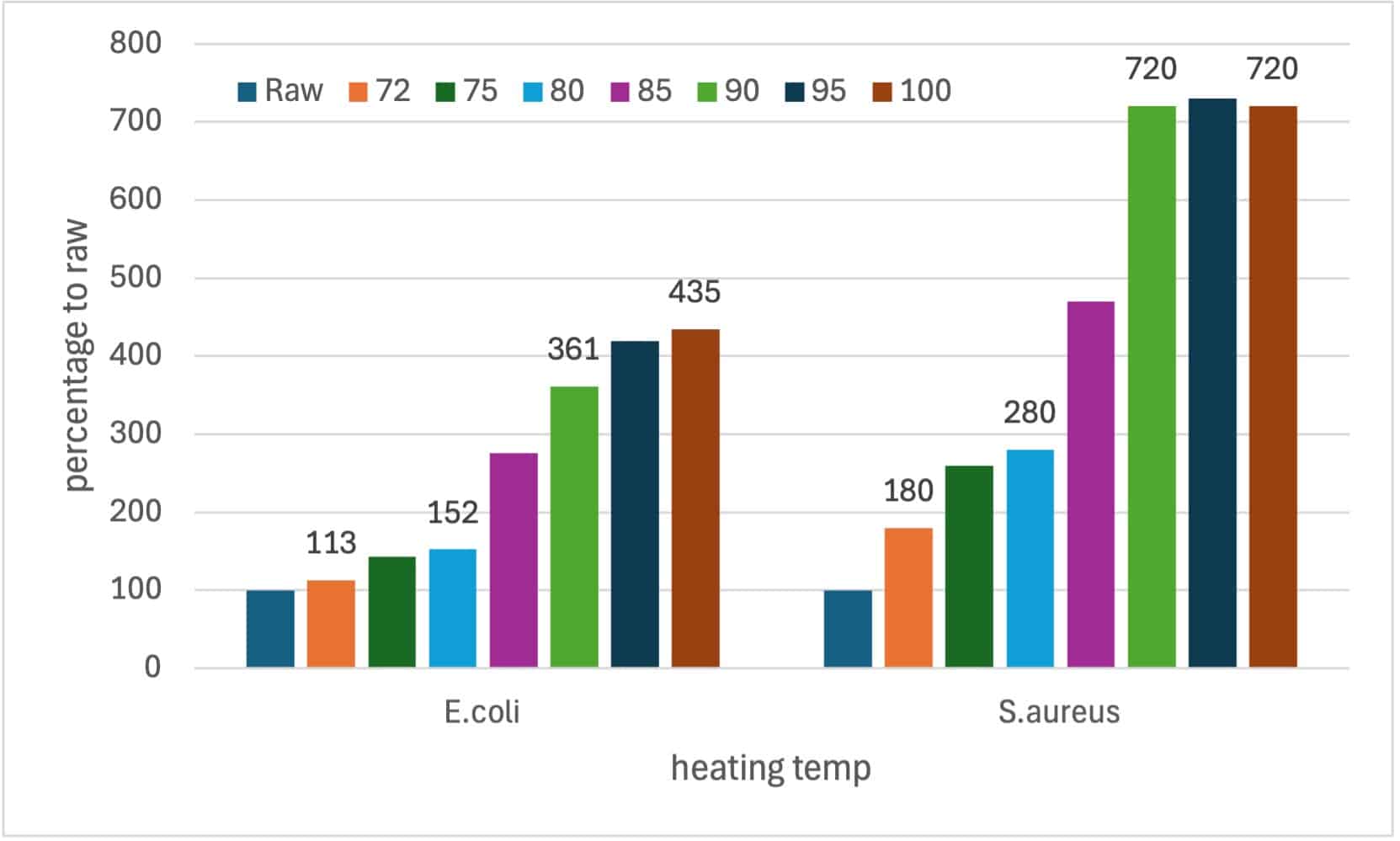
Fig. 2. The increase in Escherichia coli and Staphylococcus aureus added after heating (and cooling) the milk and relative to the outgrowth in raw milk (=100).
The loss of whey proteins and defence mechanims
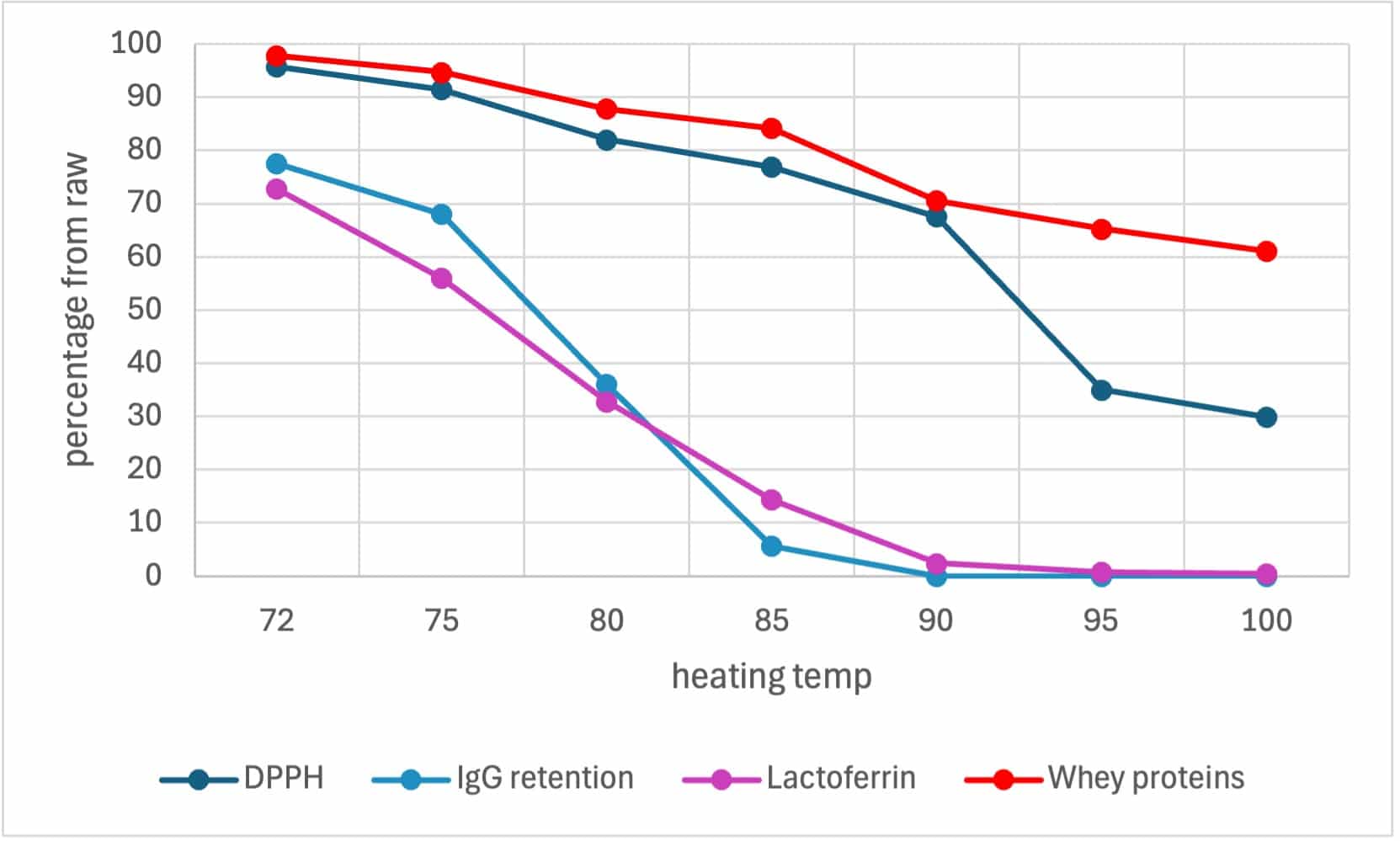
Fig. 3. Decrease in concentration by increasing heating for 15 seconds: whey protein total, Lactoferrin, Immuunglobulin G and antioxidants (as DPPH radical capture capacity) compared to the value in raw milk (=100).
Already after pasteurisation (HTST, 72oC), there is a 20-30% reduction in Lactoferrin and IgG. Both Lactoferrin and IgG play a role in immunity. Above 85oC, both substances are reduced to zero. Whey proteins tend to be more heat-sensitive than casein proteins. Altogether, the concentration of all whey proteins gradually decreases with increasing temperature. Lactoferrin is part of these whey proteins, but it is clearly more heat-sensitive. Antioxidants are instrumental in scavenging free radicals. Again, there is a sharp decline at higher (sterilisation) temperatures. Furthermore, the vitamin C content drops by over 30% and there is hardly any loss of vitamin B2. This applies to all temperatures (data not shown).
Maillard-reaction
Barely visible to the naked eye, heating creates a brown-coloured milk. This is called caramelisation. Milk sugar binds with other substances, changing, usually reducing, its activity. This is measured in the Furosine concentration.
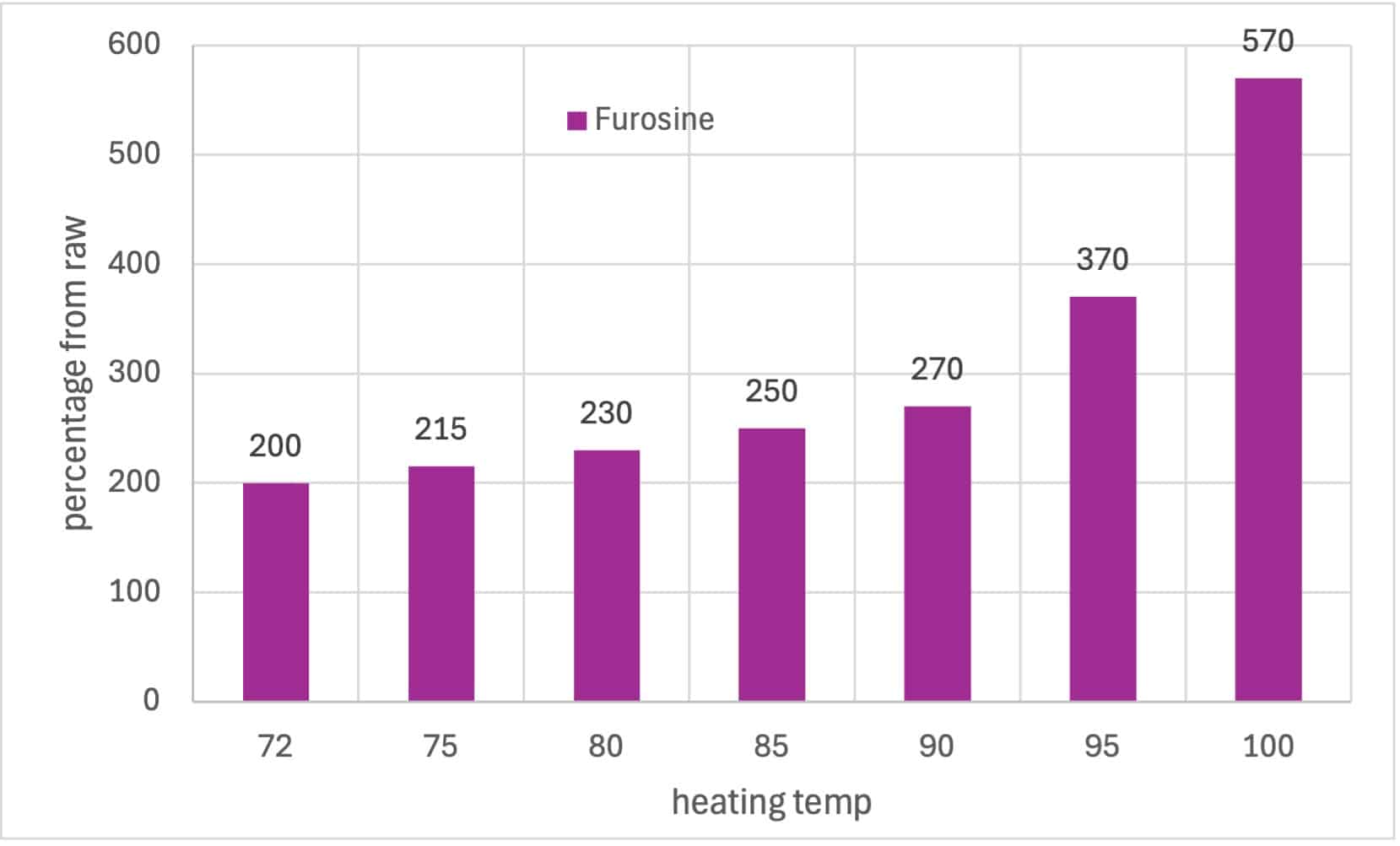
Fig. 4. Increase in Furosine as a measure of caramelisation of milk sugar, or Maillard reaction, by increasing heating of milk for 15 seconds; relative values to raw milk (=100).
When milk is really boiled, caramelisation increases sharply. However, even in pasteurised milk this is already noticeable, an aspect most people taste as a slightly sweeter milk flavour compared to raw milk.
Concentration of substances or impact on health?
By measuring substances, we try to make a statement about the health impact. However, is a decrease of a few percent ‘still tolerable’, ‘unhealthy’ and ‘harmless’? Is every substance equally important? You often don’t quite know, how different substances are digested or interact with mucous membranes, to understand the impact of heating. Casein proteins and a whey protein such as beta-lactoglobulin (BLG) are digested differently. Caseins quickly disintegrate in the (acidic) stomach, whereas BLG reaches the small intestine partly undigested and unchanged to do its job there as a transport protein.
How and if, for example, BLG has an impact on immunity, depends on the degree of denaturation by heating, but also whether the BLG protein is loaded with iron or fatty acids (Roth-Walter et al., 2020). Only the unchanged BLG can silence the immune system. Own research (Uni Utrecht and Kassel) shows, that already after pasteurisation (HTST) there is a negative effect on the immunology of mice (food allergy model), but that also multiple allergic children did not tolerate the HTST milk, in contrast to the unheated, raw milk (Abbring et al., 2019). Besides reactions to allergy or asthma, effects on growth are also known. For instance, Sieber et al. (1980) showed, that you need several generations, to visualise differences in growth of rats fed with raw or heated milk and without knowing exactly which substance or substances caused the differences in growth.
Literature
- Abbring, S., Kusche, D., Roos, T. C., Diks, M. A., Hols, G., Garssen, J., Baars, T. & van Esch, B. C. (2019). Milk processing increases the allergenicity of cow’s milk—Preclinical evidence supported by a human proof‐of‐concept provocation pilot. Clinical & Experimental Allergy, 49(7), 1013-1025.
- Blanc B. (1980). Einfluss der thermischen Behandlung auf die wichstigsten Milchinhaltstoffe und auf den ernährungsphysiologischen Wert der Milch. Alimenta-Sonderausgabe, (1980), pp 5-25
- Blanc B. (1982). Les protéines du lait à activité enzymatique et hormonale. Le Lait (1982), 62, 350-395
- Roth-Walter, F., Afify, S. M., Pacios, L. F., Blokhuis, B. R., Redegeld, F., Regner, A., … & Hufnagl, K. (2020). Cow milk protein beta-lactoglobulin confers resilience against allergy by targeting complexed iron into immune cells. Journal of Allergy and Clinical Immunology.
- Sieber, R., Rüst, P. und Blanc, B. (1980). Ernährungsphysiologischer Vergleich von roher, pasteurisierter und ultrahocherhitzter Milch in einem Langzeitversuch mit Ratten. Alimenta-Sonderausgabe, pp. 49-56.
- Shuang, J., Liu, Y., Hettinga, K., Zhang, L., Liu, X., & Zhou, P. (2024). Effects of different heat treatments on the bioactive components, bactericidal and antioxidative capacity of bovine milk. International Journal of Dairy Technology.
All figures in this article are derived from Shuang et al, 2024.

